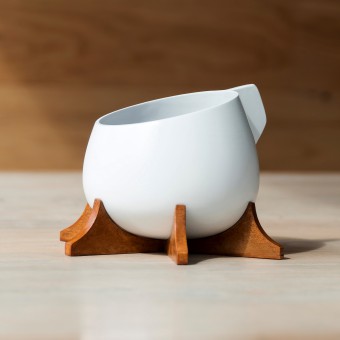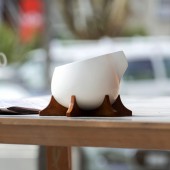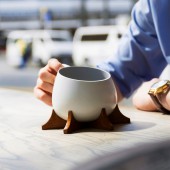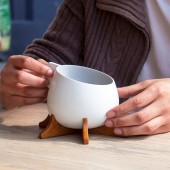Venus 3D Printed Cup by Tiger ChongSheng Guo |
Home > Winners > #97961 |
 |
|
||||
| DESIGN DETAILS | |||||
| DESIGN NAME: Venus PRIMARY FUNCTION: 3D Printed Cup INSPIRATION: Venus was inspired by the alignment of the planets of the Solar System, and the age old notion of "the stars aligning". Celestial entities often create unique and beautiful visages, with many becoming constellations, lights, or other phenomenons captured in human history. These visages are often no more than a few simple forms in perfect symbiosis, celebrated by the serendipitous surface qualities of stars and moons. Venus was inspired by this and aims to capture the beauty of forms complementing one another in a manner of purity that also honours the serendipity of material quality. To achieve this, digital fabrication was implemented. Venus takes additive manufacturing methods - such as 3D printing - and combines them with contemporary industrial design to celebrate the purity of materials reconstructed; much like celestial bodies. Traditional manufactured methods we found, were not up to the degree of quality we pursued to achieve this goal. For thousands of years; since the invention of the lathe in ancient Egypt; subtractive manufacturing methods have been implemented as the industry standard. Even today, many products are still manufactured by taking away material through cutting, sanding, and thinning. These processes are imprecise, often requiring multiple passes to compensate for flaws produced by the previous; and consequently, produce immense quantities of waste; many times the size of their products. Venus aims to break this trend. Digital fabrication introduces a new possibility; additive manufacturing; the means of production by adding material rather than subtracting. Chiefly amongst these means stands 3D printing. Whilst traditionally a prototyping tool, recent innovations in 3D printing have permitted it to become a fully-fledged manufacturing method. When combined with highly precise material quality control through a digital interface, allowing complex heterogenous forms to be created perfectly with no waste; 3D printing can produce marvels of geometry and interaction. Seizing this opportunity, Venus was designed to both captivate minimalistic contemporary industrial design, and celebrate the raw material quality through such a pure manufacturing method. After all, these same materials came from the stars millions of years ago. Venus was designed by Tiger ChongSheng Guo at Victoria University of Wellington’s School of Design. UNIQUE PROPERTIES / PROJECT DESCRIPTION: Venus is a luxury homeware set designed to encapsulate the symbiosis between two forms, and the unique qualities of 3D printed geometries. Similar products traditionally implement subtractive manufacturing methods (taking away material through cutting, sanding, and thinning). These processes are imprecise, and produce immense waste, and lack any quality from the original material. 3D printing Venus allows the unique qualities of the 3D filament (mixes of materials) to be captured serendipitously, with no waste. OPERATION / FLOW / INTERACTION: The cup element can be lifted from the base. Due to the shape, the cup can be put on the base and itself will slide into the correct alignment due to the weight of the ceramic. PROJECT DURATION AND LOCATION: The project started in July 2017 and finished in January 2018. Project was exhibited at Victoria University of Wellington's RNDR 2018 Exhibition. Reproductions have been since made using local industry, most recently in early 2020. |
PRODUCTION / REALIZATION TECHNOLOGY: The design was 3D printed at an external industry partner in a ceramic and polymer mix. The print was then fired in a kiln to finish the ceramic. The ceramic was then lightly sanded and polished. The wood base was 3D printed in a PLA and wood mix. The print was then sanded and stained. SPECIFICATIONS / TECHNICAL PROPERTIES: 137 x 154 x 109 Cup alone: 112 x 125 x 101 Base alone: 137 x 154 x 35 TAGS: venus, homeware, cup, 3d print, wood filament, luxury, victoria, vuw, design RESEARCH ABSTRACT: The project began by undergoing rapid concept ideation, aiming to explore as many forms as possible. This initially took the form of abstract form ideation, followed by iterative design, and finally volumetric design. These were all done via traditional mediums, but soon moved to digital ones. Ergonomics and anthropometric studies were undertaken with early prototypes to refine form, surface, and scale. CHALLENGE: The most challenging aspect of this project were the restraints. The design needed to be simple, sleek, and elegant, comprising of no more than 2 independent forms. The symbiosis between the forms was critical. I aimed to make it a mutually beneficial one, with one supporting the other in radial forms, much like the celestial entities within a solar system. The requirement to use 3D printing and explore materials previously not printed was also challenging. I had never worked with ceramics before, let alone 3D print them. ADDED DATE: 2020-02-06 07:17:11 TEAM MEMBERS (3) : Tiger ChongSheng Guo - Designer, Zach Challies - Tutor/Lecturer and Joshua Felizardo - Assistant Photographer/Model IMAGE CREDITS: [ Example: Image #1: Photographer ChongSheng Guo, Venus 1, 2017. ] [ Example: Image #2: Photographer ChongSheng Guo, Venus 2, 2017. ] [ Example: Image #3: Photographer ChongSheng Guo, Venus 3, 2017. ] [ Example: Image #4: Photographer ChongSheng Guo, Venus 4, 2017. ] [ Example: Image #5: Photographer Joshua Felizardo, Venus 5, 2017. ] PATENTS/COPYRIGHTS: Copyrights belong to ChongSheng Guo, 2018. |
||||
| Visit the following page to learn more: https://www.tgdesignstudio.com/venus | |||||
| AWARD DETAILS | |
 |
Venus 3d Printed Cup by Tiger Chongsheng Guo is Winner in Bakeware, Tableware, Drinkware and Cookware Design Category, 2019 - 2020.· Press Members: Login or Register to request an exclusive interview with Tiger ChongSheng Guo. · Click here to register inorder to view the profile and other works by Tiger ChongSheng Guo. |
| SOCIAL |
| + Add to Likes / Favorites | Send to My Email | Comment | Testimonials | View Press-Release | Press Kit |







